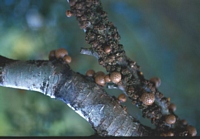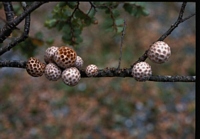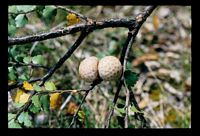|
 Cyttaria pallida Cyttaria pallida
BiostatusPresent in region - Indigenous. Endemic
Images (click to enlarge)
Owner: Hiroaki Setoguchi | 
Owner: Hiroaki Setoguchi | 
Caption: Plate 10A. Cyttaria pallida on branch of Nothofagus menziesii. (Photo A. R. Teixeira.) | 
Caption: Plate 11 B. Decorticated Cyttaria pallida galls on Nothofagus menziesii. | 
Caption: Plate 12B. Gall of Cyttaria pallida on Nothofagus menziesii sapling. | 
Owner: Hiroaki Setoguchi |
Article: Rawlings, G.B. (1956). Australasian Cyttariaceae. Transactions of the Royal Society of New Zealand 84: 19-28.
Description: Stromata solitary, or in single or double rows, up to 1.5 cm diam. sub-globose, somewhat
flattened, smooth, uniform dirty white (clay coloured), extremely viscid. Base short, hidden,
undifferentiated. Hollow at maturity, internal fibres white, orange at base. Apothecia few, up
to 50, dull orange yellow. Papillae uniformly distributed between apothecia, conical, elevated
above surface of stroma. Pycnidia absent. Asci 150-167 x 14 µ ascospores sub-globose, 7.5-12.5 x 7.5-9.5 µ, dark-coloured in mass, spore print black. Paraphyses shorter than asci, 100
x 2 µ, septate, branched.
Habitat: An obligate parasite on Nothofagus (Hook. f.) Oerst., in New Zealand causing large spindle
shaped galls.
Distribution: Range, Southland northward to Ohakune. Type collection in Forest Research
Institute herbarium, collected at Woodlaw State Forest, October, 1946. specimens.at Plant
Diseases Division, D.S.I.R., Auckland.
Notes: C. pallida appear to be nearest to the South American species C. berteroi Berk., but differs
from it in colour, size, hollow mature stroma, internal fibres and length of paraphyses.
The first sporophores were seen in Southland in 1946, somewhat later than those of C.
gunnii; spore discharge was noted on October 24.
The galls are of an entirely different type from those of C. gunnii or C. nigra. On twigs
they appear as longitudinal rows of pimples erupting through the bark, and from these the
sporophores arise singly. These galls spread and cause twisting of the branches, which
become swollen and brittle; many branches die, others suffering from breakage due to wind.
In large trees the crown becomes thin and the branches distorted.
The most striking deformity results from the fungus attacking a small shoot on the trunk of
a sapling; in this case the fungus spreads down the twig and attacks the trunk. At first a ridge
is formed beneath the bark, as growth proceeds the ridge divides into two and the final result
is a paddle-shaped -all. As an example, a sapling of l ½ in d.b.h. had a gall extending 1ft
above and 3ft below the source of infection, which was a small twig on the trunk. The canker
was 3in wide and the stern three-quarters encircled. The same stem had several such cankers
of larger or smaller size and the upper part had been killed by the attack. See Plate 12 B.
In these paddle-shaped galls the central area may be dead, covered by pimples, or may
appear to be normal bark. Most of the sporophores occupy the margins of the galls.
Article: Dingley, J.M. (1969). Records of plant diseases in New Zealand. New Zealand Department of Scientific and Industrial Research, Bulletin 192: 298 p. Wellington:.
Notes: Rawlings (1956) showed that Cyttaria pallida, unlike the other two species of Cyttaria
present in New Zealand, formed on the trees fusiforme galls, several feet long. This species
is also endemic to New Zealand.
Article: Gadgil, P.D. (in association with Dick, M.A.; Hood, I.A.; Pennycook, S.R.) (2005). Fungi on trees and shrubs in New Zealand. Fungi of New Zealand. Ngā Harore o Aotearoa 4: xi + 437 p. Hong Kong: Fungal Diversity Press.
Description: Type: Caulicolous Fungi; Description: Ascomata a hollow sphere, somewhat flattened, with the outer surface composed of a honeycomb of small, angular, cup-shaped ascigerous cavities, dirty white, up to 1.5 cm in diameter; borne on woody, perennial galls; branch and stem galls long and spindle-shaped, sometimes several feet long; gall surface under the bark with pimple-like projections. Asci cylindrical, 160 × 14 m. Ascospores subglobose, 10 × 8 m, dark, black in mass.
Distribution: Distribution: Buller, Westland, South Canterbury, Otago Lakes, Southland.; 1st Record: Rawlings (1956).
|